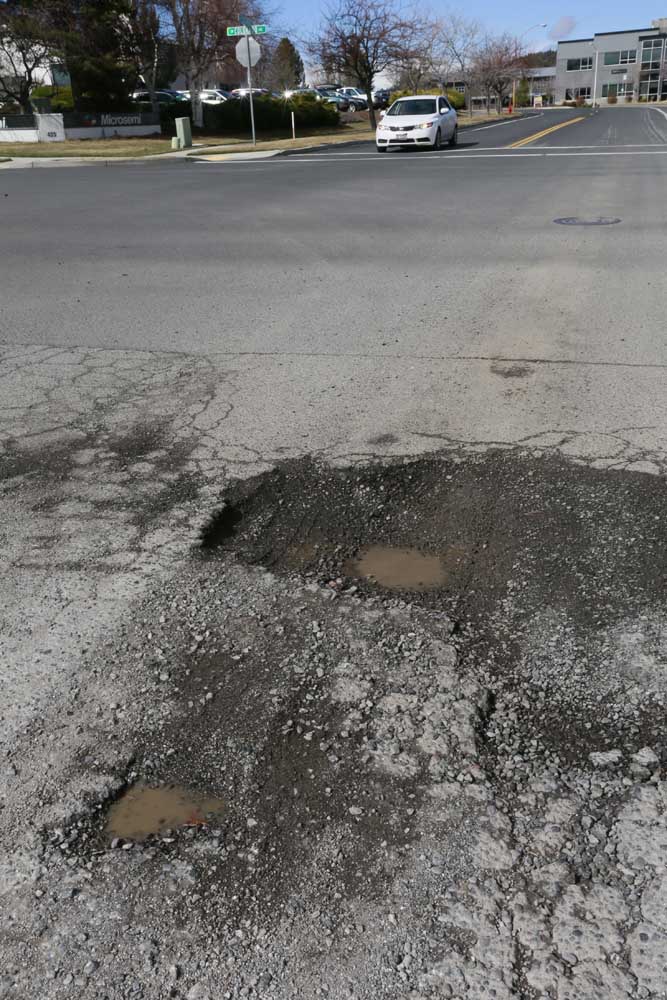Pothole predicament: why Bend’s is so deep
Published 12:00 am Thursday, March 13, 2014

- ORIG / Rob Kerr / The BulletinA large pothole is visible on the southeast corner of SW Columbia St. at SW Colorado Ave. in Bend Monday.
Winter rain and snow have opened a scattering of potholes on Bend streets, while less than 20 miles to the north, Redmond’s streets are largely pothole-free.
Hardy Hanson, Bend’s streets manager, said the city’s insufficient maintenance budget has made it difficult for the public works department to stay on top of emerging problems. Public works has roughly $2.2 million this year to address potholes and other pavement maintenance issues, he said, while the backlog of deferred maintenance has swelled to $80 million.
Hanson said while heavy vehicles, studded tires and even sunlight help deteriorate Bend’s roads, many streets simply weren’t built to hold up under the volume of traffic traveling along them. Many heavily trafficked streets in Bend have a layer of just 2 or 3 inches of asphalt, he said, when the traffic volume would call for a 6-inch to 8-inch layer.
A thicker layer of asphalt tends to crack from the bottom up rather than from the top down, Hanson said, making it more difficult for water to work its way into the roadbed and form potholes.
“A lot of these older streets were county streets and were not built very well,” Hanson said. “And then they were annexed in, and we have all these under-built streets that were carrying hundreds of vehicles a day, and are now carrying thousands.”
Bill Duerden, public works director for Redmond, said the city’s street sweepers regularly monitor the road network for potholes. In recent weeks, they’ve spotted a few places where the road shoulder is deteriorating, and a handful of small depressions where a void may be forming below the surface of the street, he said, but no true potholes.
Duerden said that at roughly $150 million, the street system is Redmond’s most valuable asset, and the city has committed to keeping it in good repair. Redmond budgeted $900,000 to paving maintenance for the current budget year.
“We don’t have a situation where we have undersized roads carrying large traffic, and we’ve got a pretty aggressive maintenance program,” Duerden said.
Bend and Redmond both rely on the “pavement condition index,” a 0 through 100 scale, with 100 being the best, to rate the condition of their street network. Redmond’s PCI has inched up in recent years to 82, while in Bend, the citywide PCI sits at 68 and, according to Hanson, is falling.
Hanson said Central Oregon’s weather extremes, particularly the 60-degree swings often seen in a single summer day, are not friendly to asphalt. Asphalt created for use in cold climates tends to get soft during the height of summer, he said, while blends designed for hotter climates grow brittle when temperatures drop.
One option the city has been exploring when building newer roads is concrete.
Long a more expensive alternative to asphalt, the two materials are now nearly equal in price, though maintenance costs for concrete are much lower during the first 10 to 20 years of a road’s life.
The section of Southeast Reed Market Road that was rebuilt last year was paved with concrete, and another section of the road between Third and 15th streets is scheduled to be paved with concrete later this year. Many of the newer roundabouts in Bend were built with concrete, and the Murphy Road project under construction on Bend’s south end is also planned as a concrete road.
When potholes emerge during the winter months on the vast majority of Bend streets paved with asphalt, public works patches them with “cold mix,” a variety of asphalt that doesn’t generally adhere as well as the “hot mix” blend produced by asphalt plants during the summer construction season.
Hanson said some of the 1,400 potholes patched between Nov. 27 and March 11 will likely have to be repaired again, but not all damage can wait until the higher-quality asphalt becomes available.
“We call it throw and go: You throw it in there so somebody doesn’t bust an axle or damage a tire. Probably 90 percent of them hold pretty well, but there’s those 10 percent. It’s kind of triage; you’re doing what you can do to get them fixed for now,” he said.
— Reporter: 541-383-0387, shammers@bendbulletin.com








